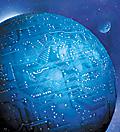 About F&D Subscribe Back Issues Write Us Copyright Information Free Email Notification Receive emails when we post new
items of interest to you. |
Letters to the editor
Global digital divide Reading Ashfaq Ishaq's article, "On the Global Digital Divide" (September 2001), I was reminded of the recommendations made during UNESCO's First World Congress on Informatics and Education more than a decade ago. One theme of the congress was the vast potential of technology to help developing nations leapfrog over the traditional stages of development and accelerate the growth of their economic and educational systems. It was believed that the emergence of more powerful technologies at lower costs also held promise for reducing the digital divide between developed and developing countries. Seven years later, however, at the Second UNESCO World Congress on Informatics and Education, we learned from the reports of member nations that the digital divide between industrial and developing countries had not been reduced but that the chasm had, in fact, grown almost exponentially since the first congress. It is important to recognize that the digital divide between developed and developing nations represents more than the lack of physical access to technology. It is, in reality, the result of a complex of factors, most of which have little to do with technology. The present digital divide between the poorest and the richest nations cannot be realistically addressed until we are able to raise the basic capacity of the former. The poorest countries will find it difficult to commit substantial resources for technology initiatives when their people are illiterate, do not have food, have limited or no health services, and lack other basic needs. Simply providing technology to the poorest countries will not close the divide. If we look at our own schools, we can see that providing physical access to computers and connectivity is not enough. In many instances, computers are sitting in schools gathering dust because teachers do not know how to use them. Research has shown that, for technology to be an effective tool in the learning process, three conditions must be met: (1) there needs to be high-quality content that is relevant to the learning needs of the students and to the educational system of the country; (2) teachers must be trained to integrate the new digital resources into their teaching practices; and (3) technical support must be readily available to address any problems that arise. Failure to meet any one of these conditions will result in a failure to reap any benefits from investments in technology.
I enjoyed Ashfaq Ishaq's article, "On the Global Digital Divide," but I have some comments. First, there is a big divide among computer and Internet users in the United States: 93 percent of households with incomes of $75,000 and above have computers, compared with only 40 percent of households with incomes of $30,000 or less. With respect to Internet access, there is a 50 percent difference between the highest- and lowest-income families. Second, a major problem young people face is how to determine the validity of the information posted on the Internet. For example, there are many rumors about who was behind the September 11 attack, who actually carried it out, and the reasons for it. Anyone can have a website, get into a chat room, and say what he/she wants. Many teachers in the United States are ill prepared to help their students with computer technology, and some school systems do not have technical backup. U.S. schools need to offer more courses on the technical aspects of the Internet, and teachers need to help children assess the validity of the information they find on the Internet. I see tremendous possibilities with the Internet and hope that it will help low-income families, both in conferring economic advantages and in providing cultural and general information, although it will be a long time before we see low-income families in the United States gaining access to the Internet and becoming proficient in its use. Programs that can help include the pilot ClickStart Program, which is run by the Marcus A. Foster Educational Institute in Oakland, California, with funding from the federal government, and various company programs that not only build a more computer-literate workforce but supply employees with added family benefits.
|